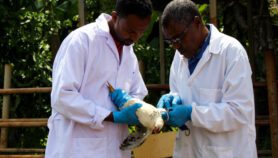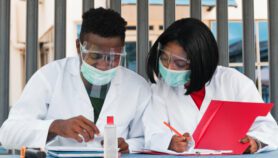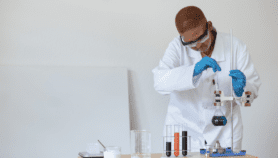By: Priya Shetty
Send to a friend
The details you provide on this page will not be used to send unsolicited email, and will not be sold to a 3rd party. See privacy policy.
Databases of traditional medicines can help protect against biopiracy while opening the doors for new drug discovery, says Priya Shetty.
Traditional biological knowledge tends to be uncomfortably juxtaposed between two worlds — the ancient, where knowledge was freely shared by all, and the modern, where it is jealously protected through patents.
But the past few months have seen milestones in bridging this divide.
This month (February), the United States Patent and Trademark Office (USPTO) partially rejected Pfizer's patent on its impotence drug, Viagra, because of similarities with a Chinese herb known as horny goat weed.
And last month, the European Patent Office (EPO) revoked a patent for a traditional remedy extracted from the roots of endemic South African plants.
Both actions are examples of a growing trend to incorporate traditional knowledge into modern patent applications. They follow agreements — signed last year by the USPTO and the EPO — with India to consult its Traditional Knowledge Digital Library (TKDL) before granting patents.
Knowledge brought to book
India's TKDL is a 24 million page, multilingual database on traditional remedies and medicinal plants.
According to Samir Brahmachari, director-general of the Council of Scientific and Industrial Research (CSIR) in Delhi, it was set up partly in response to two expensive and protracted legal battles in the 1990s over widely used traditional medicines.
In 1995, the USPTO granted a patent to the University of Mississippi Medical Center for the use of turmeric powder as a wound-healing agent. That this was not novel knowledge would have been obvious to anyone travelling through India, where turmeric-doused bandages are commonly used. But it took the Indian government two years to overturn the patent.
Another 1995 patent stood for longer still. It was not until 2000 that a patent for a neem-based fungicide — granted by the EPO to the US Department of Agriculture and the multinational W. R. Grace — was revoked.
Raghunath Mashelkar, who led the fight against the EPO patent as Brahmachari's predecessor, was a key player in setting up the TKDL and explains its significance.
"For the first time, traditional knowledge started to be codified in a language and in systems that the patent offices could use," he says.
China has a similar database on traditional Chinese medicines that is in use by the EPO.
The availability of such databases, and the willingness of developed nations to consult them during patent applications, are vital to protect the traditional knowledge of countries like China and India.
Not all developing countries have the resources to fight such wars. And doing so eats into budgets that could otherwise be spent using traditional knowledge to develop new and urgently needed treatments for diseases such as malaria.
But by providing access to traditional medicine compounds, they could also open the doors for a new wave of drug discovery.
Promise of traditional medicines
So far, attempts to bring traditional medicines into treatment practices in the developed world have largely failed. Traditional remedies are often bespoke to an individual, and the exact combination of ingredients for even common treatments may vary — which is anathema to commercial standardisation.
Nevertheless, the ability to screen libraries of traditionally used chemical compounds offers much promise that some developing countries are now quick to exploit.
The African Network for Drugs and Diagnostics Innovation, for example, includes the development of new treatments for infectious diseases from traditional medicines as one of its goals. It is pursuing this on its own and in collaboration with initiativessuch as the Global Institute for BioExploration, a global network that is investigating plant-based pharmaceuticals for diseases such as tuberculosis and malaria.
Meanwhile, the Indian Council of Medical Research's Advanced Centre for Reverse Pharmacology in Traditional Medicine, in Mumbai, is undertaking a similar approach to drug discovery, studying for example the antimalarial properties of a type of jasmine known locally as parijat.
WIPO weighs in
Of course, offering free information on traditional compounds still carries the risk of exploitation.
Devinder Sharma, chair of the Forum for Biotechnology and Food Security in New Delhi, told SciDev.Net that "TKDL facilitates biopiracy. With patent applications becoming sophisticated and huge, it is never possible to find out in which cases companies have used the information from TKDL."
Sharma adds that international guidelines and laws should be changed so that "any patent application found to be based on traditional knowledge would attract a penalty and the blacklisting of the company".
Brahmachari disagrees. He points to the success of the open-access consensus for sequencing the human genome as proof that the TKDL will work the way it is intended to.
But ensuring that it does may owe more to the support of the World Intellectual Property Organization (WIPO). In a press conference this month, WIPO director-general Francis Gurry called the "sophisticated" TKDL "a model we hope to establish in other countries around the world".
Patents only work because there are consequences from their infringement. As long as open-access traditional knowledge databases have the backing of the 'big guns' in intellectual property — both nationally and internationally — there is a good chance that traditional medicine can be brought into the modern world.

Journalist Priya Shetty specialises in developing world issues including health, climate change and human rights. She has worked as a news editor at New Scientist, assistant editor at The Lancet, and commissioning editor at SciDev.Net.













